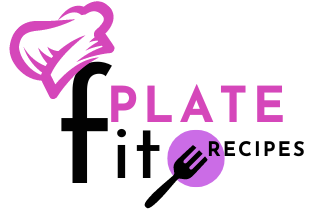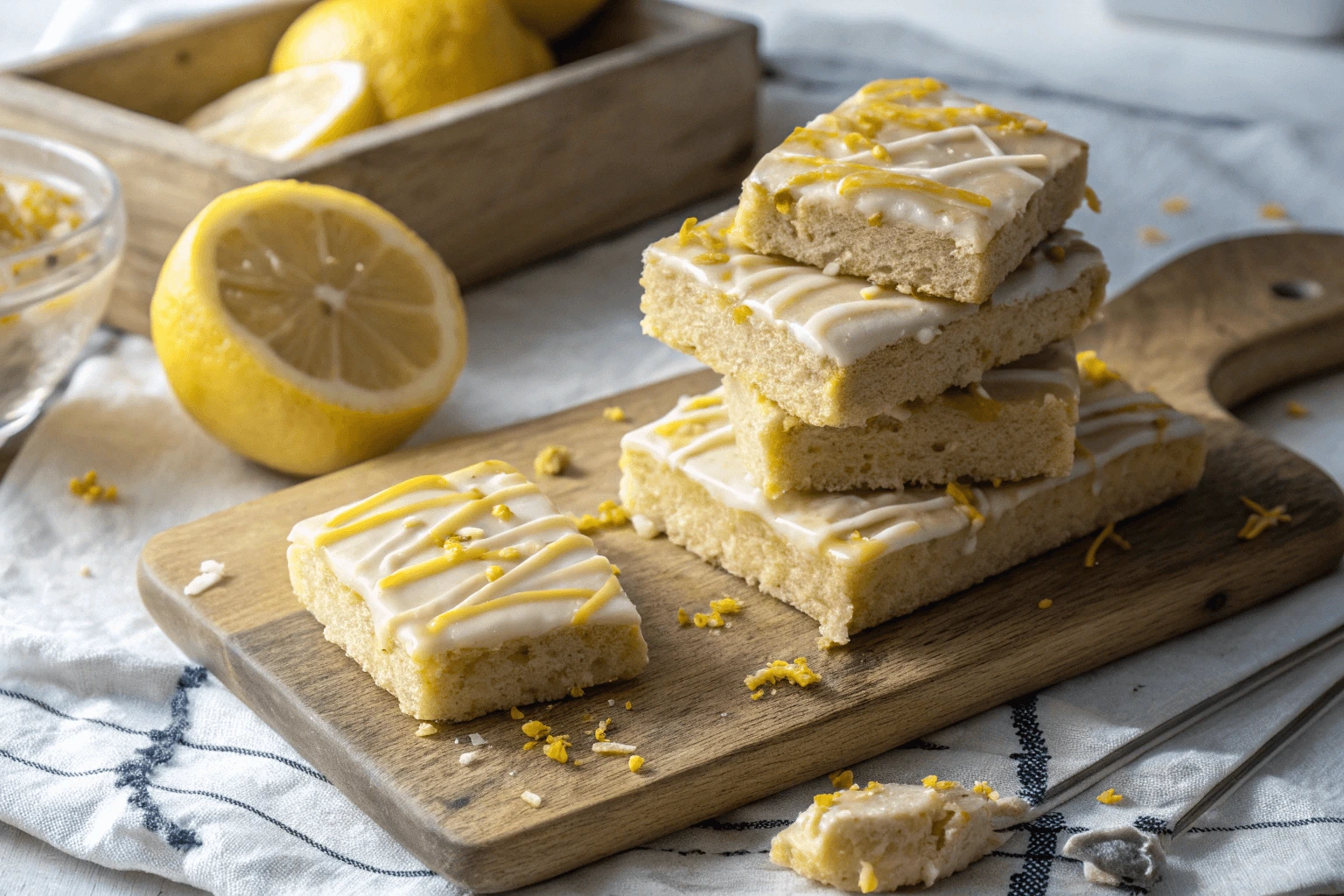The Best Homemade Lemon Protein Bars Recipe – Easy, Healthy, and Delicious!
Introduction
Looking for a tasty, protein-packed snack that’s easy to make at home? This lemon protein bars recipe is the perfect solution. Whether you need a post-workout boost, a healthy midday snack, or a way to satisfy your sweet tooth without guilt, these bars check all the boxes.
In this guide, we’ll go over everything you need to know about making homemade lemon protein bars—from ingredients and step-by-step instructions to troubleshooting common issues like why your lemon bars turn out rubbery. We’ll also discuss whether protein bars are good for weight loss and what ingredients to avoid in store-bought options.
Contents
Table of Contents
Why Make Your Own Lemon Protein Bars?
Buying protein bars at the store is convenient, but is it really the best option? Homemade bars give you total control over ingredients, taste, and nutrition. Plus, they’re often fresher, cheaper, and healthier!
The Benefits of Homemade Protein Bars
When you make lemon protein bars at home, you can:
- Control the ingredients – No artificial sweeteners, preservatives, or unnecessary fillers.
- Adjust the nutrition – Need more protein? Less sugar? It’s all up to you.
- Save money – Store-bought protein bars can be pricey. But is it cheaper to make your own protein bars? In most cases, yes! A few bulk ingredients can yield multiple batches for a fraction of the cost.
- Enjoy better flavor – Let’s be honest, some packaged bars taste chalky or artificial. Fresh, homemade bars? Way better!
Comparing Store-Bought vs. DIY Lemon Protein Bars
Not convinced? Let’s break down the differences:
| Feature | Store-Bought Bars | Homemade Bars |
|---|---|---|
| Ingredients | Often contain preservatives, artificial flavors, and added sugars | Fresh, natural ingredients with no additives |
| Cost | Can range from $2 to $5 per bar | Costs significantly less per serving |
| Taste | Some are bland or too processed | Fresh, zesty, and customizable |
| Nutrition | Varies widely, often high in sugar | You control the macros and quality |
Plus, if you’ve ever read the label on a commercial protein bar, you know how confusing the ingredients list can be. Why buy something with a long list of unpronounceable additives when you can whip up a delicious, natural lemon protein bar at home?
And let’s not forget dietary needs—whether you’re low-carb, vegan, or gluten-free, you can tweak your recipe to match your lifestyle.
Key Ingredients for the Perfect Lemon Protein Bars
The key to a delicious lemon protein bars recipe lies in choosing the right ingredients. The perfect balance of protein, natural sweetness, and zesty lemon flavor will give your bars a fresh, satisfying taste without artificial additives.
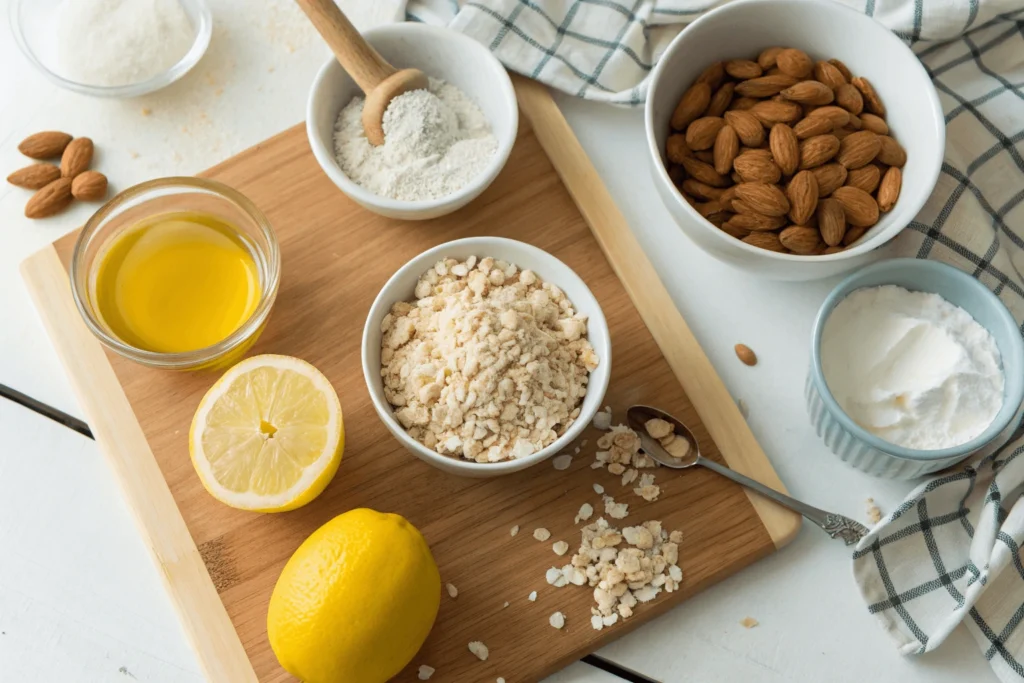
Choosing the Right Protein Powder for a Zesty Taste
One of the most important ingredients in lemon protein bars is, of course, the protein powder. But can you mix lemon with protein powder? Absolutely! The trick is picking the right type:
- Whey protein – Great for a smooth texture, but it may clump when mixed with acidic ingredients like lemon.
- Plant-based protein – Works well for dairy-free options, but some brands have a gritty texture.
- Collagen protein – Dissolves easily and pairs well with citrus flavors.
For the best taste, go with unflavored or vanilla protein powder. Strongly flavored options (like chocolate) may overpower the fresh lemon taste.
Balancing Natural Sweetness and Tartness
Lemon’s natural tartness is refreshing, but it needs the right amount of sweetness to avoid being overpowering. Instead of refined sugar, try:
- Honey or maple syrup – Adds natural sweetness with a hint of depth.
- Stevia or monk fruit – Great for keeping sugar content low.
- Medjool dates – A whole-food option that also helps with binding the ingredients together.
Using a mix of lemon juice and lemon zest will give the bars the perfect citrus punch. The zest contains essential oils that add extra fragrance and flavor!
Part 3: Step-by-Step Lemon Protein Bars Recipe
Now it’s time to bring everything together. Follow this simple lemon protein bars recipe for a nutritious, homemade snack that tastes better than anything you’ll find in a store.
Ingredients You’ll Need for a Nutritious Boost
Before you start, gather these simple ingredients:
- 1 ½ cups oats (blended into a flour)
- ½ cup vanilla or unflavored protein powder
- ¼ cup almond flour
- ¼ cup honey or maple syrup
- Juice and zest of one large lemon
- ½ teaspoon vanilla extract
- ¼ cup Greek yogurt or coconut yogurt
- 2 tablespoons melted coconut oil
- A pinch of salt
If you want to make no-bake bars, substitute Greek yogurt with nut butter for a firmer texture.
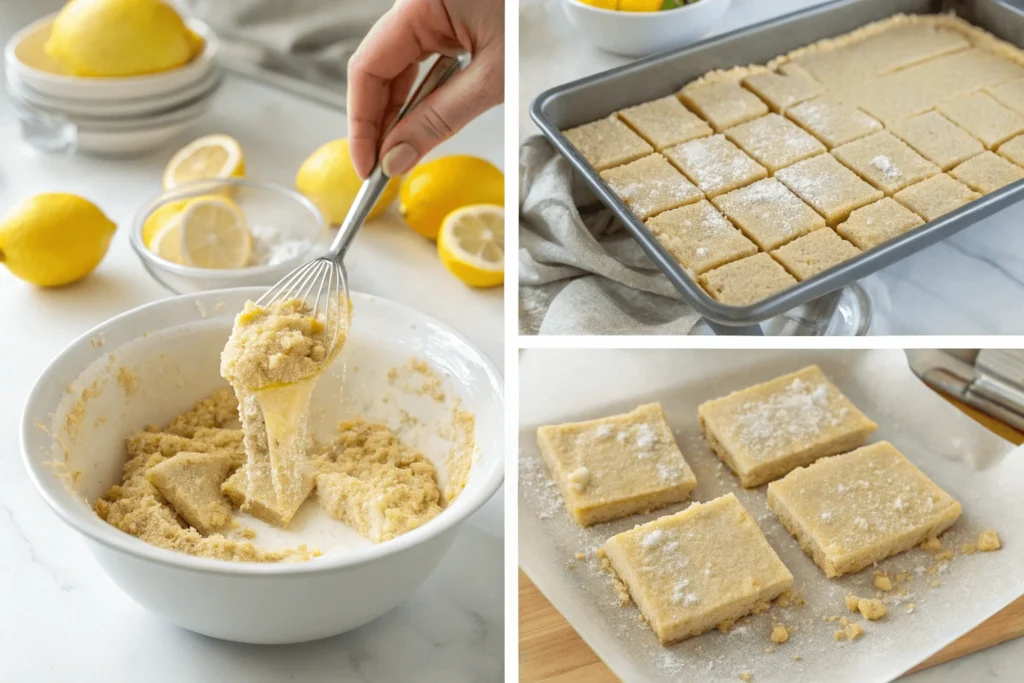
Simple Mixing and Baking Instructions for the Best Texture
Follow these steps to create the perfect lemon protein bars:
- Mix the dry ingredients – In a large bowl, combine oat flour, protein powder, almond flour, and salt.
- Add the wet ingredients – Stir in honey (or maple syrup), lemon juice, lemon zest, vanilla extract, and Greek yogurt. Mix until everything is well combined.
- Incorporate the coconut oil – Melted coconut oil helps bind everything together and keeps the bars soft.
- Press into a pan – Line an 8×8-inch pan with parchment paper and press the mixture evenly into the pan.
- Chill or bake – If making no-bake bars, refrigerate for at least an hour before slicing. If baking, preheat your oven to 325°F (160°C) and bake for 12-15 minutes, or until lightly golden.
- Cut and store – Once set, slice into bars and store in the fridge for up to a week.
Troubleshooting: Why Are My Lemon Bars Rubbery?
If your bars turn out rubbery or too chewy, a few things could have gone wrong:
- Too much protein powder – Excess protein can make bars dense and tough.
- Not enough fat – Healthy fats (like coconut oil or nut butter) help with texture.
- Overbaking – Keep an eye on them to prevent drying out.
Part 4: Customizing Your Lemon Protein Bars to Fit Your Diet
One of the best things about making your own lemon protein bars recipe is that you can tweak the ingredients to fit your dietary needs. Whether you’re following a low-carb, high-protein, dairy-free, or vegan diet, there’s a way to make these bars work for you.
Low-Carb, High-Protein Variations
If you’re watching your carb intake, swapping out certain ingredients can make a big difference:
- Use coconut flour instead of oats – Coconut flour is low in carbs and absorbs moisture well.
- Choose a low-carb sweetener – Stevia, monk fruit, or erythritol are great sugar alternatives.
- Go for almond butter instead of Greek yogurt – This adds protein and healthy fats while keeping carbs down.
A high-protein, low-carb version of this lemon protein bars recipe will help keep you full longer while supporting muscle recovery.
Dairy-Free and Vegan-Friendly Options
If you avoid dairy, making these bars vegan is simple:
- Swap Greek yogurt for coconut yogurt or nut butter – Both options help maintain the right texture.
- Use plant-based protein powder – Pea, rice, or hemp protein work well.
- Replace honey with maple syrup or agave – This keeps the recipe fully plant-based.
By adjusting a few ingredients, you can make sure these bars fit perfectly into your diet without losing their delicious lemon flavor.
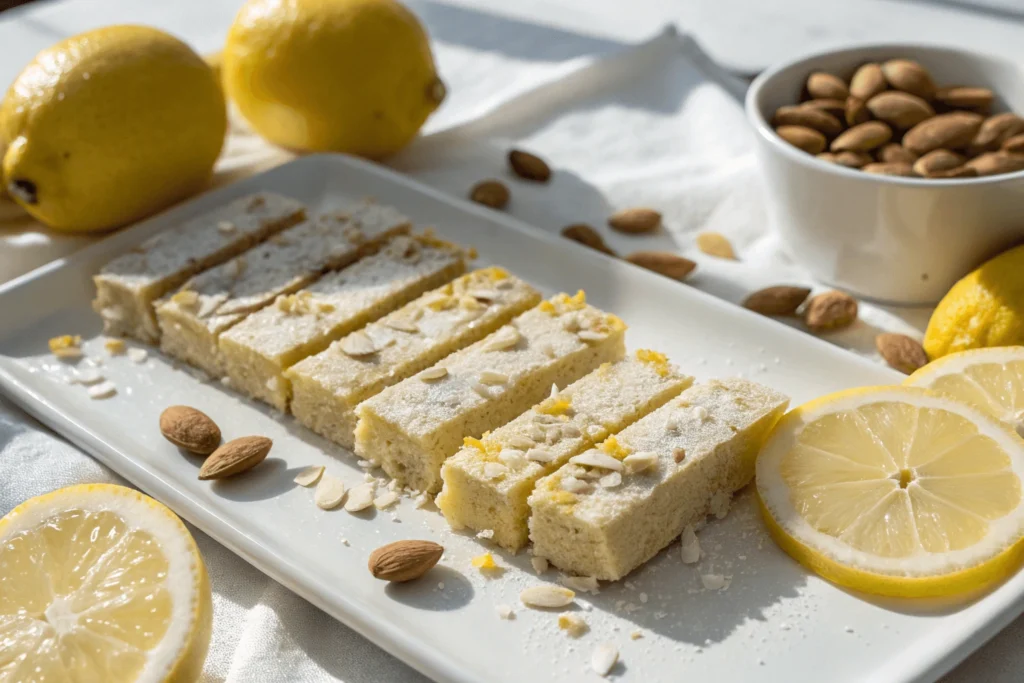
Common Mistakes When Making Lemon Protein Bars
Sometimes, things don’t turn out quite right. If your bars are too dry, too sticky, or just not the right texture, here’s what might have gone wrong.
Why Your Bars Turn Out Too Dry or Too Sticky
Getting the texture right is key. If your bars seem too dry, you may have:
- Added too much protein powder, which absorbs moisture quickly.
- Used not enough binding ingredients like honey or nut butter.
- Skipped the coconut oil, which adds softness.
On the other hand, if your bars are too sticky:
- They may need more dry ingredients, like almond flour or oats.
- Refrigerating them longer can help them firm up.
- Too much honey or syrup can make them overly soft, so reduce if needed.
The Secret to Getting the Perfect Chewy Texture
Nobody wants bars that are rubbery or rock-hard. Why are my lemon bars rubbery? It usually happens because:
- Overmixing the protein powder – This can make the mixture too tough.
- Too much liquid – Adding too much lemon juice or yogurt can throw off the balance.
- Baking for too long – If you bake your bars, keep an eye on them to prevent over-drying.
Looking for More Healthy Snack Ideas?
For more delicious, protein-packed snack ideas, check out the Healthy Recipes section on Fit Plate Recipes!
How to Store and Keep Your Protein Bars Fresh
Once you’ve made your lemon protein bars recipe, proper storage is key to keeping them fresh and tasty. Whether you plan to eat them within a few days or save them for later, following the right storage methods will maintain their texture and flavor.
Best Ways to Store for Maximum Freshness
Homemade protein bars don’t have preservatives like store-bought ones, so they need a little extra care. Here’s how to keep them fresh:
- Refrigerate for short-term storage – Store the bars in an airtight container and keep them in the fridge for up to one week.
- Wrap individually for grab-and-go convenience – Use parchment paper or small containers to prevent them from sticking together.
- Avoid direct sunlight or heat – If you leave them out, they may soften too much or spoil faster.
Can You Freeze Homemade Protein Bars?
Yes! Freezing is a great way to make your lemon protein bars recipe last longer without losing flavor or texture. Here’s the best way to do it:
- Wrap each bar individually – This keeps them from sticking together.
- Place them in a sealed container or freezer bag – This prevents freezer burn.
- Label with the date – They’ll stay fresh for up to three months.
When you’re ready to eat, simply let a bar thaw at room temperature for 10-15 minutes. Now that you know how to store them properly, let’s talk about the best times to enjoy these protein-packed snacks!
When and How to Enjoy Your Lemon Protein Bars
Timing matters when it comes to protein intake. Whether you need an energy boost before a workout or a filling snack between meals, these bars fit right into your routine.
Best Times to Eat for Energy and Muscle Recovery
Are protein bars ok for weight loss? Absolutely—when eaten at the right times. Here’s when they work best:
- Pre-workout fuel – A bar 30-60 minutes before exercise provides steady energy.
- Post-workout recovery – Eating one within 30 minutes after a workout helps muscle repair.
- Midday snack – They’re perfect for keeping hunger in check between meals.
If you’re wondering how much protein should I eat to lose weight, experts suggest 0.6 to 1 gram per pound of body weight daily. A protein bar can help you hit that target without unnecessary sugar or additives.
Pairing Lemon Protein Bars with Other Healthy Snacks
For a more balanced snack, pair your lemon protein bars with:
- A handful of almonds or walnuts – Adds healthy fats and crunch.
- Greek yogurt – A great source of probiotics and extra protein.
- A smoothie – Blend with berries and spinach for a nutrient-packed drink.
Eating your bars with a mix of protein, healthy fats, and fiber helps keep you full longer and supports weight management.
Nutritional Breakdown of Lemon Protein Bars
Making your own lemon protein bars recipe means you know exactly what’s going into your food. Unlike store-bought bars, which often contain hidden sugars and preservatives, homemade bars give you clean, balanced nutrition.
Macronutrient Profile: Protein, Carbs, and Fats
Each bar’s nutritional content depends on the ingredients you use, but here’s an estimate per serving (assuming you make 10 bars per batch):
- Calories: 180-220 kcal
- Protein: 12-15g (depending on the protein powder)
- Carbohydrates: 15-20g (mostly from oats or natural sweeteners)
- Fats: 7-10g (from coconut oil, nuts, or seeds)
- Fiber: 3-5g (from oats and almond flour)
If you’re wondering, are protein bars ok for weight loss? Yes! They help manage hunger, especially when packed with fiber and protein.
How These Bars Support Weight Loss and Muscle Gain
Protein is essential for both muscle recovery and appetite control. But how much protein should I eat to lose weight? Experts recommend 0.6 to 1 gram per pound of body weight daily.
Since these bars contain a good mix of protein, healthy fats, and slow-digesting carbs, they help:
- Keep you full longer, preventing unnecessary snacking.
- Support muscle recovery after workouts.
- Maintain steady energy levels throughout the day.
Unlike some store-bought options, this lemon protein bars recipe contains no artificial fillers or added sugars, making it a great choice for both weight loss and fitness goals.
FAQs About Lemon Protein Bars
Is It Cheaper to Make Your Own Protein Bars?
Yes! Making your own lemon protein bars recipe is usually cheaper than buying pre-packaged bars. Bulk ingredients like protein powder, oats, and almond flour can make multiple batches at a lower cost than store-bought alternatives, which can be overpriced.
Can I Mix Lemon with Protein Powder?
Absolutely! Some worry about acidity affecting protein powder, but most high-quality powders blend well with citrus flavors. If you’re concerned, try collagen or plant-based protein, as they mix well without clumping.
Why Are My Lemon Bars Rubbery?
If you’ve asked, why are my lemon bars rubbery? It’s likely because:
- Too much protein powder makes them dense.
- Overbaking dries them out.
- Not enough fat (like coconut oil or nut butter) reduces softness.
Are Protein Bars Ok for Weight Loss?
Yes! A homemade protein bar with natural ingredients, fiber, and the right macronutrients can help manage weight. Just be mindful of portion sizes and avoid added sugars or unhealthy fats.
What to Avoid in Protein Bars?
When making or buying protein bars, watch out for:
- Artificial sweeteners that cause bloating.
- Hydrogenated oils that add unhealthy fats.
- High sugar content that causes energy crashes.
How Much Protein Should I Eat to Lose Weight?
For effective weight loss, aim for 0.6-1g of protein per pound of body weight daily. A homemade lemon protein bar can help you reach this goal without the extra junk found in commercial bars.
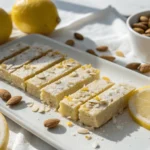
How to Make Lemon Protein Bars – Quick, Healthy & Tasty!
- Total Time: 1 hour 15 minutes
Description
This lemon protein bars recipe is a healthy, protein-packed snack that’s perfect for weight loss, post-workout recovery, or a quick energy boost. Made with natural ingredients, these bars are easy to prepare and free from artificial sweeteners.
Ingredients
- 1 ½ cups oats (blended into oat flour)
- ½ cup vanilla or unflavored protein powder
- ¼ cup almond flour
- ¼ cup honey or maple syrup
- Juice and zest of one large lemon
- ½ teaspoon vanilla extract
- ¼ cup Greek yogurt or coconut yogurt
- 2 tablespoons melted coconut oil
- A pinch of salt
Instructions
- Prepare dry ingredients: In a large bowl, mix oat flour, protein powder, almond flour, and salt.
- Add wet ingredients: Stir in honey, lemon juice, lemon zest, vanilla extract, and Greek yogurt. Mix well.
- Incorporate coconut oil: Melt the coconut oil and blend it into the mixture.
- Press into pan: Line an 8×8-inch pan with parchment paper and evenly press the mixture into it.
- Chill or bake:
- For no-bake bars: Refrigerate for at least 1 hour before slicing.
- For baked bars: Preheat the oven to 325°F (160°C) and bake for 12-15 minutes until lightly golden.
- Cut and store: Slice into bars and store in the fridge for up to a week.
Notes
- Why are my lemon bars rubbery? If they turn out too chewy, reduce the protein powder and avoid overmixing.
- Can I mix lemon with protein powder? Yes! Stick to unflavored or vanilla protein for the best taste.
- For a vegan version, swap Greek yogurt for nut butter and honey for maple syrup.
- These bars can be frozen for up to 3 months—just thaw before eating.
- Prep Time: 10
- Cook Time: 12-15
